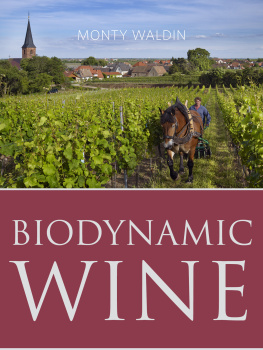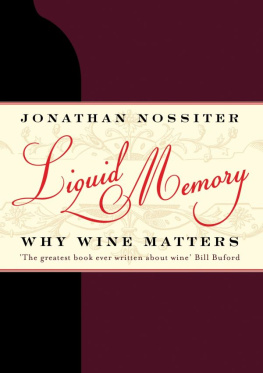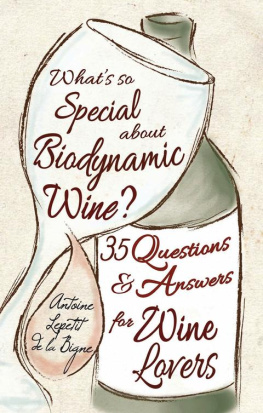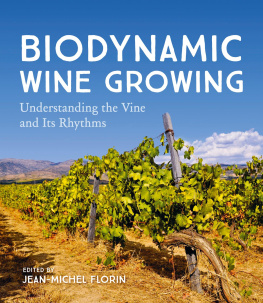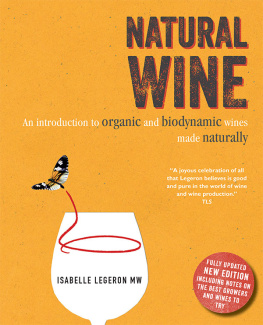THE CLASSIC WINE LIBRARY
Editorial board: Sarah Jane Evans, Joshua Greene, Richard Mayson
There is something uniquely satisfying about a good wine book, preferably read with a glass of the said wine in hand. The Classic Wine Library is a series of wine books written by authors who are both knowledgeable and passionate about their subject. Each title in The Classic Wine Library covers a wine region, country or type and together the books are designed to form a comprehensive guide to the world of wine as well as an enjoyable read, appealing to wine professionals, wine lovers, tourists, armchair travellers and wine trade students alike.
The series:
Port and the Douro , Richard Mayson
Cognac: The story of the worlds greatest brandy , Nicholas Faith
Sherry , Julian Jeffs
Madeira: The islands and their wines , Richard Mayson
The wines of Austria , Stephen Brook
Biodynamic wine , Monty Waldin
Spirits distilled, Mark Ridgwell
The story of champagne , Nicholas Faith
The wines of Faugres , Rosemary George
BIODYNAMIC
WINE
MONTY WALDIN
Monty Waldin sensed, when working as a teenager on a conventionally run Bordeaux chteau in the mid-1980s, that the more unnecessary sprays were applied to the grapes, the more additives and other corrective treatments were needed subsequently during the winemaking. By the mid-1990s Monty had become the first wine writer to specialize in green issues. His first book, The Organic Wine Guide (Thorsons, 1999), published whilst Monty developed a biodiversity project for a Demeter-certified biodynamic vineyard in California, was voted Britains Wine Guide of the Year. He followed this with the multi-award-winning Biodynamic Wines (Mitchell Beazley, 2004). Monty drew on his winemaking experiences in Chile for Wines of South America (Mitchell Beazley, 2003), winner of Americas prestigious James Beard Book Award. In 2007, whilst living in the Roussillon in France, Monty was filmed by Britains Channel 4 for Chteau Monty, the first ever observational TV documentary on biodynamic winemaking from pruning to bottling (a six-part series broadcast in 2008). His other books include Discovering Wine Country: Bordeaux (2005, Mitchell Beazley), Discovering Wine Country: Tuscany (2006, Mitchell Beazley), Chteau Monty (Portico, 2008), Monty Waldins Best Biodynamic Wines (Floris, 2013) and Biodynamic Gardening (Dorling Kindersley, 2015). Monty has contributed to Hugh Johnsons Pocket Wine Guide (Mitchell Beazley), Tom Stevensons Wine Report (Dorling Kindersley), and writes the entries for biodynamics, organics and natural wine amongst others in The Oxford Companion to Wine (ed. Jancis Robinson MW, OBE). He has also appeared on BBC TV and Radio (The World Service, Radio 4s Food Programme ), and has contributed to British newspapers ( Independent, Daily Mail, Londons Evening Standard ), and websites (www.jancisrobinson.com), as well as to wine, travel and environmental publications including Decanter, World of Fine Wine, Le Pan Media, Harpers Wine & Spirit Trade Review, The Ecologist, Star & Furrow (the journal of the UK Biodynamic Agricultural Association) and Biodynamics (the journal of the USA Biodynamic Farming and Gardening Association). Monty is a regular speaker at conferences on green issues and has advised vineyards and wineries in both hemispheres who are looking to green up.
There is practically no field of human endeavour that does not relate to agriculture in some way.
Rudolph Steiner
Copyright Monty Waldin, 2016
The right of Monty Waldin to be identified as the author of this book has been asserted in accordance with the Copyright, Designs and Patents Act 1988.
First published in 2016 by
Infinite Ideas Limited
36 St Giles
Oxford
OX1 3LD
United Kingdom
www.infideas.com
All rights reserved. Except for the quotation of small passages for the purposes of criticism or review, no part of this publication may be reproduced, stored in a retrieval system or transmitted in any form or by any means, electronic, mechanical, photocopying, recording, scanning or otherwise, except under the terms of the Copyright, Designs and Patents Act 1988 or under the terms of a licence issued by the Copyright Licensing Agency Ltd, 90 Tottenham Court Road, London W1T 4LP, UK, without the permission in writing of the publisher. Requests to the publisher should be addressed to the Permissions Department, Infinite Ideas Limited, 36 St Giles, Oxford, OX1 3LD, UK, or faxed to +44 (0) 1865 514777.
A CIP catalogue record for this book is available from the British Library
ISBN 978-1-910902-39-4
Cover photos: top Mick Rock/Cephas Picture Library; bottom Matt Wilson/Cephas Wine Library.
All other photos courtesy of the author.
INTRODUCTION
Wines are generally defined in one of three ways: by their country or region of origin, by their colour (red, white, pink) or by their style (still, sparkling, fortified). Only recently have wines begun to be defined according to how they have been grown and made. There is now a clear if over-simplistic divide between modern conventional or chemical winegrowing on the one hand and green alternatives on the other. These include natural wine, an increasingly popular term now in both hemispheres but which is unregulated and banned in, for example, Italy, and organic and biodynamic wine, both of which are independently regulated. Organic and biodynamic vines comprised around 6 per cent (and rising) of the global vineyard in 2015, up from less than 0.5 per cent in 1999. The bulk of the organic vineyards are found in Europes wine powerhouses of France (the Midi, Provence, Alsace), Italy (Sicily, Calabria, Tuscany) and Spain (Penedes, La Mancha), as well as Germany (Rhine regions, Baden) and Austria. In the southern hemisphere, Chile seriously underperforms for a country claiming to be a wine paradise (perfect winegrowing climate, few pests, free Andean irrigation, no phylloxera), and Australia does not bother to collect national stats on organics. In contrast, New Zealand has set itself the most ambitious target of any wine-producing nation, namely to have 20 per cent of its (currently 33,300 hectare) vineyard certified by 2020.
Nevertheless, sceptics deride biodynamics as an extreme form of organics, with its quasi-religious overtones and possibly even voodoo practices, and at best merely organic agriculture with a peculiar twist. Biodynamic wine is one of those often everyday yet also conveniently rarefied products capable not just of encouraging that change, but of leading it.
FOUR WAYS TO FARM GRAPES
Traditional subsistence
From around 12,000 years ago hunter-gatherers began domesticating plants and animals. Traditional subsistence farms emerged. In terms of resources, says biodynamic farming consultant Andrew Lorand, subsistence farms make above-average use of what is already available on the farm or grown there, so little needs to be bought in. In wine, for example, rather than purchasing wooden support posts for vines, fruit trees can be planted as supports instead. Their fruit also provides an extra crop. However, because the traditional subsistence system produces even fewer outputs than inputs, little if any of the farms produce being sold or even bartered, ultimately this system is not economically sustainable. The closest modern-day equivalents of traditional subsistence vineyards still a feature in some Latin American, Mediterranean and eastern European countries form part of mixed smallholdings or farms in which wine is a minor activity. Any wine produced is for the family table rather than for sale.
Industrial
Modern industrial farming and winegrowing were spawned by the agricultural and industrial revolutions. In the industrial system any resources either already available on the farm or grown on it are poorly used. An example would be if prunings or grape residues left over from winemaking each year were burnt rather than recycled as compost, or were left to compost by neglect on the vineyard in ways that might actually increase pest and disease problems later on. Although the modern industrial system is capable of producing huge outputs lots of bottles of wine this is only at the expense of even greater inputs. In the vineyard such inputs might include soluble fertilizers to boost yields and man-made sprays to control weeds, pests and diseases. In the winery aids, additives and agents, like enzymes, acids, tannin, sugar, yeast and yeast food, can be purchased to compensate for grapes lacking colour, freshness, texture, ripeness and fermentability respectively. Most contemporary wines, whether sold in bottle or bulk, result from this system. The vineyard and winery become conduits through which myriad materials pass, few if any of which enhance the most precious and irreplaceable resource of all for a winegrower, namely the soil.
Next page
